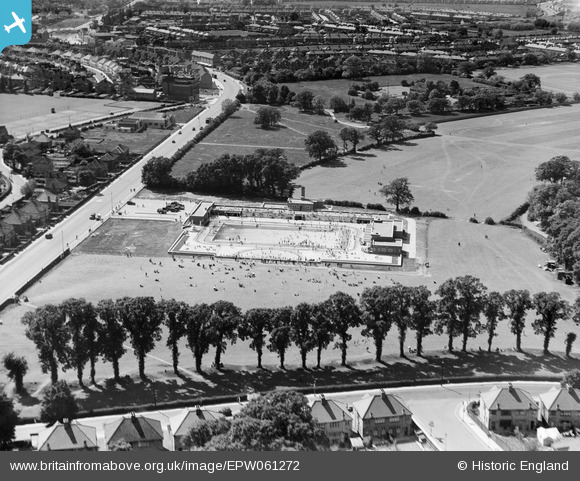EPW061272 ENGLAND (1939). The Kingsbury Lido, Kingsbury, 1939
© Copyright OpenStreetMap contributors and licensed by the OpenStreetMap Foundation. 2026. Cartography is licensed as CC BY-SA.
Details
| Title | [EPW061272] The Kingsbury Lido, Kingsbury, 1939 |
| Reference | EPW061272 |
| Date | 31-May-1939 |
| Link | |
| Place name | KINGSBURY |
| Parish | |
| District | |
| Country | ENGLAND |
| Easting / Northing | 520070, 188807 |
| Longitude / Latitude | -0.2667563737495, 51.584837587219 |
| National Grid Reference | TQ201888 |
Pins

PhilWHS |
Tuesday 17th of September 2013 07:04:08 PM | |

PhilWHS |
Friday 30th of August 2013 07:38:45 PM | |

PhilWHS |
Thursday 29th of August 2013 11:31:33 AM | |
I have fond memories of this dance hall in the early 1960's. Brian Poole and the Tremeloes, and Shane Fenton and the Fentones were groups I recall seeing there. Shane later reinvented himself as Alvin Stardust. The Kingsbury Lido was my preferred swimming pool of the local options. It was certainly a very popular meeting place in the summer. Strange how we didn't worry about the water temperature in the unheated pool. |

colsouth111 |
Sunday 1st of September 2013 05:12:41 PM |

Chris Luck |
Saturday 24th of August 2013 03:36:50 PM | |
The name Kingsbury Manor was given to the house by George Cloke, a haulage contractor and property developer, when he bought it in 1929. It had originally been named "The Cottage" by the Duchess of Sutherland (who by 1899 was married to her third husband, Sir Albert Rollitt MP), and was lived in by her daughter Irene, Countess Bubna, from around 1902 until at least 1912 |

PhilWHS |
Friday 30th of August 2013 07:09:17 PM |

Chris Luck |
Saturday 24th of August 2013 03:06:42 AM | |

Chris Luck |
Saturday 24th of August 2013 02:55:48 AM | |

Chris Luck |
Saturday 24th of August 2013 02:53:21 AM |
User Comment Contributions
I learn to swim here with my then current school in about 1946. |

fern |
Monday 18th of July 2016 01:37:43 PM |
Now we expand our remit to Kingsbury and my preferred swimming pool in the area. Burnt Oak is joined at the hip with Kingsbury, the old district boundary bisecting the Canada Park estate across Vancover Road and the Chase. As a teenager I made good friends with many Kingsbury lads as some of my Burnt Oak friends were at school in Kingsbury. |

colsouth111 |
Saturday 14th of December 2013 07:32:42 PM |
What a wonderful image of Kingsbury Swimming Pool in its first season! Wembley Urban District Council approved a proposal to build an open air swimming pool, on land that it was in the process of acquiring for a park, in March 1935. The "Olympic size" pool, 55 yards long by 25 yards wide and with a capacity of 458,000 gallons, was designed by the Council's Engineer and Surveyor, Cecil S. Trapp. Construction began in April 1938, with Commercial Structures Ltd of Leyton as the main contractor. The pool, which had cost around £40,000, was opened to the public with a grand ceremony on 13 May 1939. Its season ran from May to September each year, with the pool open from 6.30am to 9.30 or 10pm. Daily tickets cost 6d for adults and 4d for children, with school children charged just 2d during the school summer holidays. |

PhilWHS |
Sunday 25th of August 2013 12:06:28 PM |


![[EPW061272] The Kingsbury Lido, Kingsbury, 1939](http://britainfromabove.org.uk/sites/all/libraries/aerofilms-images/public/100x100/EPW/061/EPW061272.jpg)
![[EAW018257] The Kingsbury Lido, Kingsbury, 1948. This image has been produced from a print.](http://britainfromabove.org.uk/sites/all/libraries/aerofilms-images/public/100x100/EAW/018/EAW018257.jpg)
![[EAW018258] The Kingsbury Lido, Kingsbury, 1948. This image has been produced from a print.](http://britainfromabove.org.uk/sites/all/libraries/aerofilms-images/public/100x100/EAW/018/EAW018258.jpg)



